All these buckets of rain; so depressing. I had to cancel on the Gunks the weekend before last, and it looked like the next weekend might be a washout too. But undaunted, I planned for a Gunks Sunday with Liz and Adrian and hoped for the best.
It was quite foggy the whole way up to Exit 18. When we arrived at the cliffs, the path beneath the Near Trapps was muddy. The air seemed pregnant with moisture. But the rock appeared dry, or at least dryish. We walked in the direction of Gelsa (5.4), figuring it would be best to start with something easy. We dodged puddles on the trail.
Our plans changed when we stopped to look at Grand Central (5.9), a three-star classic. The vertical cracks at the start were very attractive to my crack-addicted partner Adrian. For my part, I was game for a three-star 5.9, but I wasn't sure I wanted to do it if the rock was damp. What happened to that easy warm-up we were going to do?
Adrian wasn't going to be denied. He was ready to go. So I said okay. But I didn't want to be on the hook for the crux second pitch, so I suggested he combine the short 5.6 pitch one and the steep 5.9 pitch two.

(Photo: Into the mist on Grand Central (5.9))
It turned out that the rock felt fine. Adrian flew up the first two pitches of Grand Central. He got to the traditional first belay in no time, then tiptoed through the rightward traverse around a nose to a stance beneath the steep, crux face on pitch two. Adrian complained about the traverse being a little spicy (his actual words were "that's a-one spicy meatball!") but I thought he had good pro. He then tried a couple different tactics before settling on his approach to the crux face. He started up right, then stepped down and went up left to the belay stance beneath the pitch three roof.
When I followed Adrian up I saw why Grand Central is such a great classic. There is a lot of variety on this climb. I enjoyed the crack climbing at the bottom, which is no giveaway, and the traverse around the nose, while not very difficult, is thin and quite exposed. I felt like I would have been fine leading the crux 5.9 face climbing that concludes pitch two, but the gear seems to come only at the very beginning of the crux moves, and the leader has to be comfortable working it out through the moves above this gear until the crux is basically over. It isn't particularly run out, but neither is it one of those one-move cruxes with gear over your head. There are several straightforward but steep moves in succession. I thought going to the right was definitely "the way" to do it. There are really good holds over there; every third one felt like a bomber jug to me.

(Photo: Getting started on pitch three of Grand Central)
By the time we all arrived at the belay I wasn't worried about the rock anymore; I was eager to lead pitch three. This pitch is short, but it is a doozy, through a big two-tiered overhang. Dick Williams says the pitch will go at 5.7 to 5.9 depending on your height. Immediately above the belay the huge roof looms. There is a notch running through the roof that provides a perfect slot for a #2 Camalot and a fist jam that isn't quite as good as you want it to be. The trick, if you're short like me and my partner Liz, is to find a way to get your feet up so you can reach for the jug above the roof. If you're a little taller, like Adrian, you can just stand there and grab the jug, making the climb a few grades easier and infuriating all of your partners in the process.
After a couple of false starts, stepping up, sliding/stepping/hopping down, then adding another back-up piece in case I fell out, I really went for it and it was a blast. I pulled up over the roof into a cramped, pumpy stance, wormed in another cam, moved awkwardly one step to the left, pulled over the second (easier) overhang, and it was over.
I couldn't recall a more exciting 20 feet of climbing. It was a great rush, and if you call it a 5.9 pitch, I would say it's a great introductory 5.9 lead. The hardest move is the very first one, and there's great gear. If you fail to grab the jug you can hop right down to the stance, as I did a couple of times.
In retrospect, I think it would be better to combine pitches two and three, rather than combining one and two as we did. This arrangement would better minimize drag. But I'm happy we combined one and two, because I got to lead pitch three!
After we were done with Grand Central we found Roseland (5.9), another three-star classic, sitting open. Dick Williams calls the first pitch one of the best 5.9s in the Gunks. I had never considered climbing Roseland before, but after taking one look at it I was eager to get on it. Roseland goes up a vertical crack at the back of a pretty open book. Halfway up the crack, there's a roof. And at at the end of the crack, a traverse under an overhang leads to the final moves up to a bolted anchor.

(Photo: approaching the first roof on Roseland)
It looked hard. And it was seeping a little water. But I also thought the pro looked great. The vertical crack seemed like it would provide secure placements at will. I figured the climbing would be a lot like the first pitch of Airy Aria, a corner climb in the Trapps that was one of my first 5.8 leads, and one that I really enjoyed.
I told Adrian I wanted this one. He was fine with it.
And then I proceeded to get my ass kicked a little bit.
I headed up the opening crack, placing lots of gear, having fun. The moves were great. Every step seemed technical, interesting. before I knew it I was at the roof. The crack continued around the side of the roof, providing good holds. I pulled up over the roof with no problems. Things were going well.
I was almost at the traverse. As I neared the top of the crack, the climb grew steeper, pumpier. I could see a pin out on the traverse, beneath the ceiling. It was a burly angle piton. I couldn't wait to clip it. But first I had to get established in the horizontal crack under the roof. This crack would provide the only handholds for the traverse. And the crack starts out very thin. With the pump clock ticking, I had no time to waste. I made a big step out, putting my right toe on a crease. I tried to stick my fingers in the crack. There was chalk all over it, so I thought I could use it. But I couldn't get my tips into it. The crack was too thin.
Suddenly I got scared, and a little spooked. I felt pumped, I was leaning out, and I had nothing to hold on to.
"Dude, watch me!" I yelled at Adrian. "I think I'm about to fall!"
I looked down and my last piece was, to my surprise, below my feet. I wanted gear higher, at the top of the vertical crack. I reversed the moves, going left and down a step. Then I got in a great cam and clipped it before saying "take" and hanging off of it.
I needed to regroup.
As I rested there a minute I looked over the traverse. I could now see the holds; I just hadn't reached far enough. And the feet followed an obvious line of edges. If I'd been more patient I might have seen all of this the first time. This was going to be okay.
Once I got going again, the first move of the traverse was the hardest. I made the big step and with great relief clipped the first pin. Moving to the second pin, the climbing was pumpy but I felt pretty secure with the hands and the feet. The traverse got easier as it progressed, and although I've read complaints that Roseland has gotten too polished, I can't say that problem ever entered my mind while I was climbing it.
After the traverse Roseland still comes at you: another couple of steep moves and a big mantle get you, finally, to the bolts.
As I look back on it, I think I did reasonably well with the actual climbing on Roseland, but the other aspects of my performance really suffered. I got scared and had to take. My rope management was horrible, creating so much drag that by the time I reached the anchor I could barely move the ropes. And I fumbled with a biner and dropped some nuts on the traverse. What can I say? This climb got to me a little bit. It was hard for me.
When I lowered off of it I felt exhausted.
But oh, what a great pitch. Roseland is packed with quality moves. It is a stiff 5.9 that just doesn't let up. I was sort of correct in figuring that it would be a like Airy Aria, except Roseland is longer, steeper, more technical, and includes a roof problem in the middle and a thin traverse at the end. Aside from all that, it is just like Airy Aria!
I would gladly lead Roseland again, and I hope to send it next time. Despite its difficulty I would recommend it to anyone looking for a 5.9 to try, because it takes such great gear. You can throw in a piece and take a break at any point if you want to. You would take a swing backwards if you blew the crux move to the pin, but so long as you place gear at the top of the vertical crack I don't think a fall there would be too bad.
After we'd all had our fill of Roseland I ran over to check on Birdland, a climb that has been on my ticklist for a long, long time. Something about the first pitch face just calls to me, begging me to climb it. It ascends the right-hand face of a big open book, much larger than Roseland's. The angle appears reasonable; the face seems so climbable. I have stood before it on several occasions and been so excited at the prospect of hopping on it. But I've held back, partly out of fear. Testpiece face climbs scare me, and Birdland is known as a testpiece face climb. It is a 5.8, but some people think it should be a 5.9.
The crowds have also kept me away. Birdland may be the most popular climb in the Nears. It always seems to be occupied. Both pitches are very highly regarded, and the first pitch ends at bolts that can be used to toprope several popular harder climbs around the corner as well.
Earlier in the day we weren't surprised to find Birdland occupied. But after we did Roseland, we found it open. And after my brave struggle with Roseland I realized I no longer feared Birdland. Gunks face climbs have felt really good to me lately. I felt good on Pas De Deux. I felt good on Apoplexy. Why not Birdland? It was time.
The only problem was that my buddy Adrian wanted to lead it. I had snatched Roseland from him, after all. It was his turn. And yet I had to have pitch one, and I told him so. I confessed I'd been working up to this lead for a long time. And bless his heart, he let me have it. Such a nice guy.
The pitch went down like butter.
It is a beautiful pitch. Great rock on a nice face. The line wanders just a bit but there is a natural path to it, pretty much straight up through flakes, then a touch right to the arete, then straight up again through the face to the anchor. After an initial steep cruxy move to get established on the face the angle is low, so there's no pump factor, just a bunch of great moves with very good pro.

(Photo: A mini-crux right off the deck on Birdland)
At one point there was an interesting move, right before a fixed piton, in which I stepped on a tiny pebble to move up. And afterwards I realized I had just done the crux everyone talks about. I recall reading about this crux; it is reputed to involve iffy pro and a "secret" crimper hold. But I had a good cam right before this move (I think it was a .3 or .4 Camalot in a vertical crack), and the so-called secret hold was so covered in chalk there was no way it could remain much of a mystery. For me, on this particular day, the crux was over before I even realized it was a challenge.
I'm not trying to pooh-pooh the crux of Birdland as if it's no big deal. Liz struggled with it when she followed the pitch, and she's a great climber. Last year I'm sure it would have been a whole different experience for me, too. And that's really my point: it is amazing how things can change when you lose a little weight and adjust your mindset. I'm now in a so much healthier place, both physically and mentally, than I was a year ago. Last year I wanted to believe I was still as solid as ever on Gunks 5.8s, but in the wake of my climbing accident I was really a different climber, worrying and shaking my way up climbs I would have cruised through before the accident. Now that I'm feeling good again I realize just how far I was set back.
It's so good to pick up where I left off, working on 5.9s and feeling awesome on the 5.8s. Reaching the bolts at the end of pitch one of Birdland was a little like a homecoming to me, even though I'd never been in that particular spot before. Everything about it seemed familiar and right. I can only pray to the climbing gods that the good karma continues; I know now how fragile progress can be. One stupid mistake or blown muscle and it could all get set back to zero. It happens all the time.
After the joy of pitch one I expected pitch two to be an afterthought. I had never given it much consideration before. But I knew it was supposed to be good, and very different from pitch one. From our vantage point at the bolts it sure looked steep. It was supposed to be Adrian's lead, but as we stood at the belay he told me that if I was into leading it he didn't mind giving it to me.
I was taken aback. I told him I'd be thrilled to lead it but that I didn't want to be a hog about it. He handed me the gear.
The second pitch of Birdland is not better than the first, but I think it is equally good. It starts with the technical crux, a few thin moves right above the anchor, to a pair of pitons that I'm guessing used to form the belay station for pitch one. After that, it is an overhanging jugfest up to a big, left-facing corner. There are ledges along the way if you want to take a rest. And then the physical crux comes: a steep and awkward pull up into the big corner.
Once you're in the corner, an easier traverse with good pro brings you to an escape from the roof and the finish. A very high quality pitch, with good pro the whole way. Steep and pumpy, it provides the perfect counterpoint for the technical face-climbing on pitch one. To my mind these two pitches together make Birdland perhaps the very best 5.8 in the Gunks.
No wonder it's so popular.
 my favorites actually. Although the weather can be variable, it is still very pleasant for the most part. Climbing in September can also lead to a lot more solitude on a mountain where that is sometimes hard to find. Routes like the Emmons and the Kautz, which can be extremely busy during mid-summer, turn into full-on wilderness experiences in September. Something very notable about this year that is different from previous ones is that the routes still have a lot more snow on them than normally would be present in late August. This means instead of climbing glacial skeleton and having to wind around what may seem like endless fields of huge crevasses to reach the summit, climbers are treated to what can only be described as excellent climbing!
my favorites actually. Although the weather can be variable, it is still very pleasant for the most part. Climbing in September can also lead to a lot more solitude on a mountain where that is sometimes hard to find. Routes like the Emmons and the Kautz, which can be extremely busy during mid-summer, turn into full-on wilderness experiences in September. Something very notable about this year that is different from previous ones is that the routes still have a lot more snow on them than normally would be present in late August. This means instead of climbing glacial skeleton and having to wind around what may seem like endless fields of huge crevasses to reach the summit, climbers are treated to what can only be described as excellent climbing! 
+(1).jpg)

 We decided that since we wanted to get one more load of firewood we would also cut us a Christmas tree this year. We stopped at the Jemez Ranger Station to buy the permit to cut the tree then went up the mountain to cut wood. After we had the wood loaded we searched till we found the perfect little tree and cut it and loaded it on top of the wood to bring it home.
We decided that since we wanted to get one more load of firewood we would also cut us a Christmas tree this year. We stopped at the Jemez Ranger Station to buy the permit to cut the tree then went up the mountain to cut wood. After we had the wood loaded we searched till we found the perfect little tree and cut it and loaded it on top of the wood to bring it home.

 It looks like this pair of feetwill be loosing 5 out of 10 toe nails. Likely the result of a combination of running andclimbing abuse?
It looks like this pair of feetwill be loosing 5 out of 10 toe nails. Likely the result of a combination of running andclimbing abuse? 



 Hallux Abducto Valgus (bunions), hammer toe, onychocryptosis, and Plantar Fasciitis haveall plague this pair of feet. Much of the damageis a given from hereditary. But much of the damage could have been mitigated by the use of a prescription orthotic early on ( or even a well fitted off the shelf orthodic)and more carefully picking the approach and climbing footwear to be used.
Hallux Abducto Valgus (bunions), hammer toe, onychocryptosis, and Plantar Fasciitis haveall plague this pair of feet. Much of the damageis a given from hereditary. But much of the damage could have been mitigated by the use of a prescription orthotic early on ( or even a well fitted off the shelf orthodic)and more carefully picking the approach and climbing footwear to be used.  I think there should be much more concern with several issues on mtn boots. Firstis the low quality generally worthless, insoles boots are delivered with today. I have $700 and $1000 production boots that come with insoles that sell for less than .10 cents a pair. Come on!
I think there should be much more concern with several issues on mtn boots. Firstis the low quality generally worthless, insoles boots are delivered with today. I have $700 and $1000 production boots that come with insoles that sell for less than .10 cents a pair. Come on!




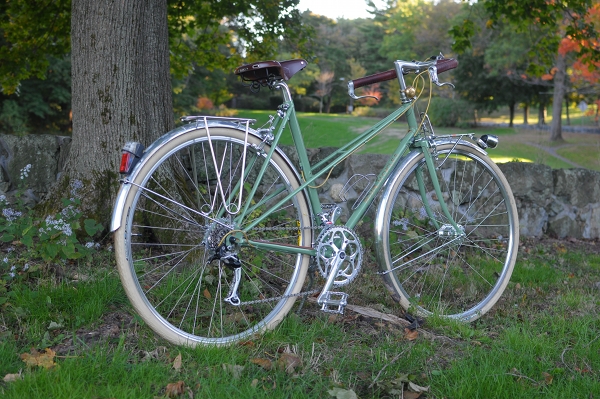 Trying to write a definitive post about the completion of my custom mixte (whom I have named "Constance") has been overwhelming, but I am forcing myself to do itbefore too much time goes by. Perhaps it will help if I try to cut down on the sappy stuff and just write about it briefly, matter-of-factly. After all, it's just a bike forgoddsake... Right!
Trying to write a definitive post about the completion of my custom mixte (whom I have named "Constance") has been overwhelming, but I am forcing myself to do itbefore too much time goes by. Perhaps it will help if I try to cut down on the sappy stuff and just write about it briefly, matter-of-factly. After all, it's just a bike forgoddsake... Right!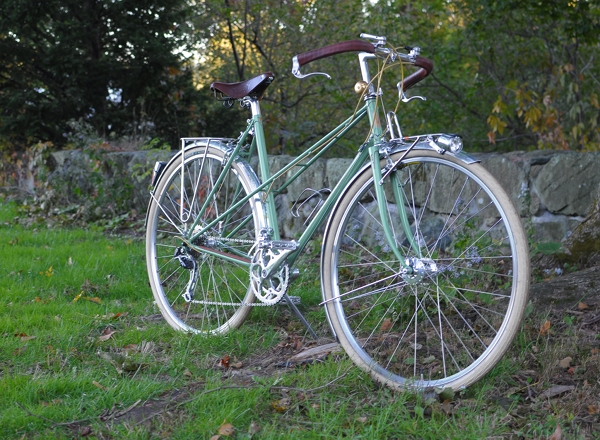 In September of last year I met Bryan Hollingsworth, who is the framebuilder behind Royal H. Cycles, and asked him to make me a custom mixte frame in the tradition of theFrench constructeurs. The frame was finished on my birthday this February. One by one, I purchased all the components, and the Co-Habitant and I put the bike together at the end of the summer. The bicycle was complete in September , about a year after its inception. If you are interested in the step by step details of the process, you can read all about it by scrolling through these posts; they document the bike from the initial stages of frame design to tweaking the component choices.
In September of last year I met Bryan Hollingsworth, who is the framebuilder behind Royal H. Cycles, and asked him to make me a custom mixte frame in the tradition of theFrench constructeurs. The frame was finished on my birthday this February. One by one, I purchased all the components, and the Co-Habitant and I put the bike together at the end of the summer. The bicycle was complete in September , about a year after its inception. If you are interested in the step by step details of the process, you can read all about it by scrolling through these posts; they document the bike from the initial stages of frame design to tweaking the component choices.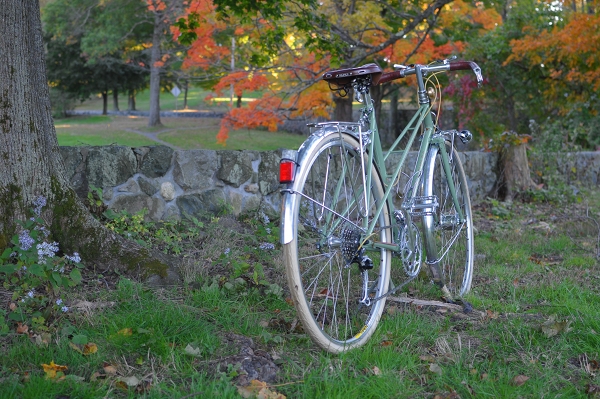 To start with a basic description of the bicycle, it is a classic, fully lugged mixte frame with twin lateral stays.The tubing is eclectic, designed with comfort and strength as the main priorities: The downtube and seat stays areColumbus. The seat tube isNova. The chainstays areVitus. And the twin stays are domestic 4130 straight gauge.
To start with a basic description of the bicycle, it is a classic, fully lugged mixte frame with twin lateral stays.The tubing is eclectic, designed with comfort and strength as the main priorities: The downtube and seat stays areColumbus. The seat tube isNova. The chainstays areVitus. And the twin stays are domestic 4130 straight gauge. The 52cm frame has a 54cm virtual top tube, 73
The 52cm frame has a 54cm virtual top tube, 73 The liquid paint and lug outlining were done byCircle A Cyclesin Providence, RI.
The liquid paint and lug outlining were done byCircle A Cyclesin Providence, RI. The "dusty mint" colour was matched to a swatch I provided. The Royal H. insignia and lug outlining were done in copper.
The "dusty mint" colour was matched to a swatch I provided. The Royal H. insignia and lug outlining were done in copper. As far as construction goes, several neat features make the bicycle special. To start with, it is nearly impossible to have a fully lugged mixte built nowadays, because the twin headtube lugs are no longer made. These were procured new old stock.
As far as construction goes, several neat features make the bicycle special. To start with, it is nearly impossible to have a fully lugged mixte built nowadays, because the twin headtube lugs are no longer made. These were procured new old stock. The "bullet" style seat stay caps were the framebuilder's idea and I was not sure I wanted them at first, but they look spectacular.
The "bullet" style seat stay caps were the framebuilder's idea and I was not sure I wanted them at first, but they look spectacular. The flat-top fork crown has a small custom embellishment, and notice the little lugged braze-on for the shifter boss. I should mention that this bicycle has clearances for 35mm+ tires plus fenders...
The flat-top fork crown has a small custom embellishment, and notice the little lugged braze-on for the shifter boss. I should mention that this bicycle has clearances for 35mm+ tires plus fenders... Everything that could possibly be lugged on this mixte, is!
Everything that could possibly be lugged on this mixte, is! - including these amazing triple sockets on the rear dropouts. Read more about them, and other aspects of the lugwork here(not to mention the custom stainless steel kickstand plate!).
- including these amazing triple sockets on the rear dropouts. Read more about them, and other aspects of the lugwork here(not to mention the custom stainless steel kickstand plate!).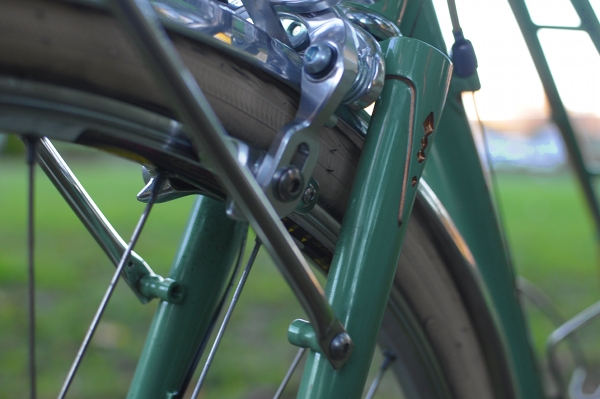 There are braze-ons for both front and rear racks, and the bicycle was built to accommodate reasonable front and rear loads.
There are braze-ons for both front and rear racks, and the bicycle was built to accommodate reasonable front and rear loads.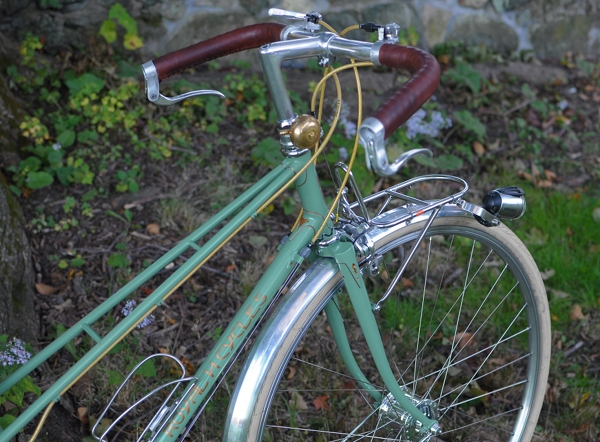 If you are interested in a full technical description of the components, you can find thathere. But for those who just want the main points of interest, I will describe a few.
If you are interested in a full technical description of the components, you can find thathere. But for those who just want the main points of interest, I will describe a few.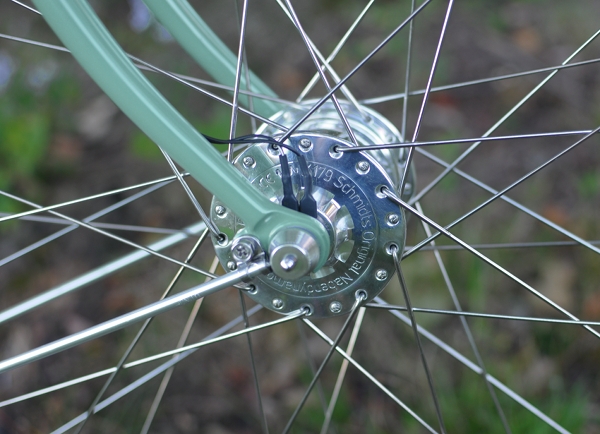 The 700C wheels were built by Peter White, with a Schmidt SON dynohub to power the lights. The headlight and tail light are the same as on my Rivendell, and you can read about them here.
The 700C wheels were built by Peter White, with a Schmidt SON dynohub to power the lights. The headlight and tail light are the same as on my Rivendell, and you can read about them here.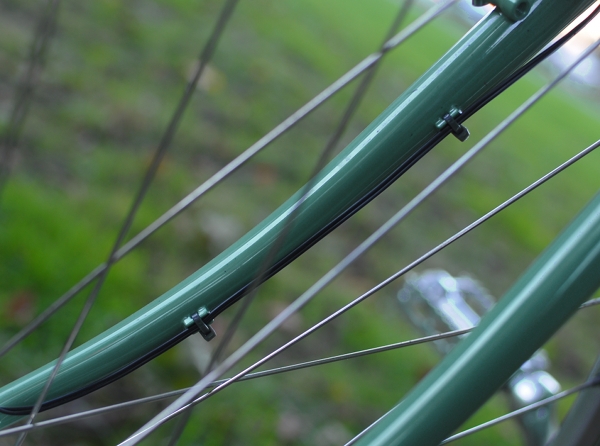 Braze-ons along the inside of the fork accommodate the wiring for the headlight.
Braze-ons along the inside of the fork accommodate the wiring for the headlight.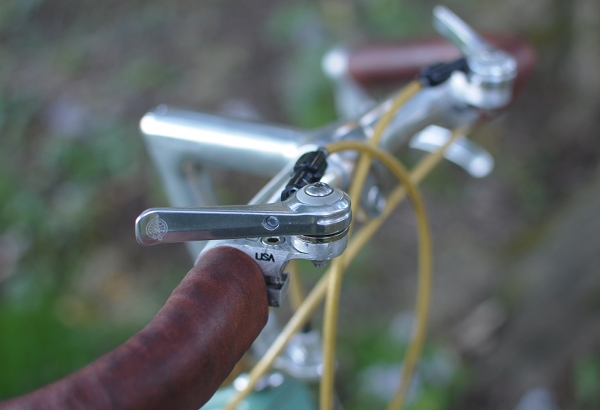 The handlebars are the Velo OrangePorteurbars, used with a 10mm stem, inverse brake levers, and Silver shifters inserted into Paul thumbies - which were heavily modified for the purpose.
The handlebars are the Velo OrangePorteurbars, used with a 10mm stem, inverse brake levers, and Silver shifters inserted into Paul thumbies - which were heavily modified for the purpose.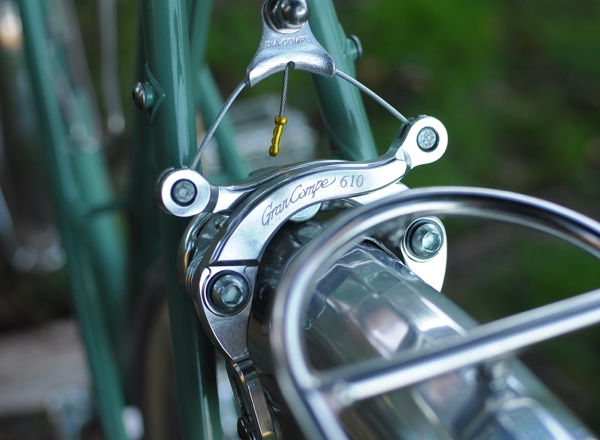 The bicycle was built to accommodate centerpull brakes, as this is my preferred style of brakes. The brakes are Dia Compe centerpulls from VO - which function great, but had to be slightly modified to fit properly (which, as I understand, is a problem other have had as well).
The bicycle was built to accommodate centerpull brakes, as this is my preferred style of brakes. The brakes are Dia Compe centerpulls from VO - which function great, but had to be slightly modified to fit properly (which, as I understand, is a problem other have had as well). The crankset is a Sugino Alpina double. You can't tell in this picture, but there is a neat braze-on for the front derailleur.
The crankset is a Sugino Alpina double. You can't tell in this picture, but there is a neat braze-on for the front derailleur. The rear derailleur is the Shimano XT "Shadow". I love this derailleur, because it tucks in closely to the wheel, so that it is less likely to get dinged if you are riding off-road, or even if the bike gets slammed by a door. Given that I have nearly destroyed the rear derailleur on my Rivendell in half a year's time, I think the "Shadow" was made for me. Oh, and if you are wondering what that monstrous-looking cassette is, that is a Sheldon Brown custom touring cassette.Please be honest about this one: how bad does this look? I considered switching the biggest ring (currently a 34t) to a slightly smaller one, so that it blends in with the others visually - though over time the weirdness of it has grown on me.
The rear derailleur is the Shimano XT "Shadow". I love this derailleur, because it tucks in closely to the wheel, so that it is less likely to get dinged if you are riding off-road, or even if the bike gets slammed by a door. Given that I have nearly destroyed the rear derailleur on my Rivendell in half a year's time, I think the "Shadow" was made for me. Oh, and if you are wondering what that monstrous-looking cassette is, that is a Sheldon Brown custom touring cassette.Please be honest about this one: how bad does this look? I considered switching the biggest ring (currently a 34t) to a slightly smaller one, so that it blends in with the others visually - though over time the weirdness of it has grown on me. The bicycle is fitted with the beautiful Honjo"Le Paon" fenders (similar to the VO "Zeppelins" I have on my Rivendell, but shinier and somehow more elegant), and the front rack is a VO Randonneur.
The bicycle is fitted with the beautiful Honjo"Le Paon" fenders (similar to the VO "Zeppelins" I have on my Rivendell, but shinier and somehow more elegant), and the front rack is a VO Randonneur. The rear rack is a VO Constructeur, which is small but can nonetheless fit a standard Dutch-size pannier. Oh, and the tires are (big surprise!) Schwalbe Delta Cruisers, 700C x 35mm. And I think I will stop now with the components, before I put everybody to sleep! If you have questions after reading this post and the spec list here, please ask in the comments and I will be glad to answer.
The rear rack is a VO Constructeur, which is small but can nonetheless fit a standard Dutch-size pannier. Oh, and the tires are (big surprise!) Schwalbe Delta Cruisers, 700C x 35mm. And I think I will stop now with the components, before I put everybody to sleep! If you have questions after reading this post and the spec list here, please ask in the comments and I will be glad to answer.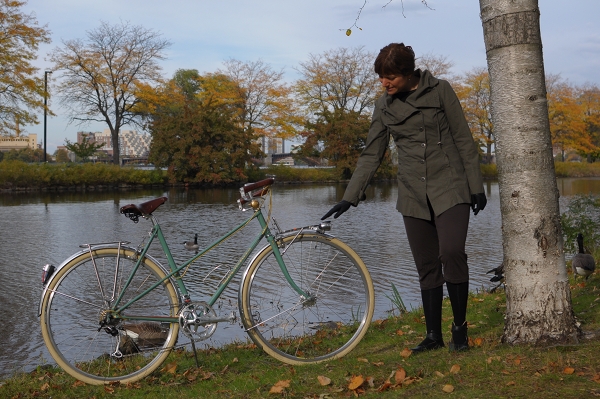 My impression of the mixte is multi-layered, but all the layers can be placed firmly in the category of "love". The bicycle handles differently than I had imagined, but only because I had no way of imagining something I had never experienced before. It is freakishly light, and luxuriously, almost abnormally comfortable while at the same time being faster and more responsive than any upright bicycle I have ridden before. It is more responsive than the vintage mixte, "Marianne," I used to own, which I had complained was "twitchy". Somehow, on the Royal H.the responsiveness does not feel scary; I can control it. No idea how this all works, but I am certainly happy about it.
My impression of the mixte is multi-layered, but all the layers can be placed firmly in the category of "love". The bicycle handles differently than I had imagined, but only because I had no way of imagining something I had never experienced before. It is freakishly light, and luxuriously, almost abnormally comfortable while at the same time being faster and more responsive than any upright bicycle I have ridden before. It is more responsive than the vintage mixte, "Marianne," I used to own, which I had complained was "twitchy". Somehow, on the Royal H.the responsiveness does not feel scary; I can control it. No idea how this all works, but I am certainly happy about it.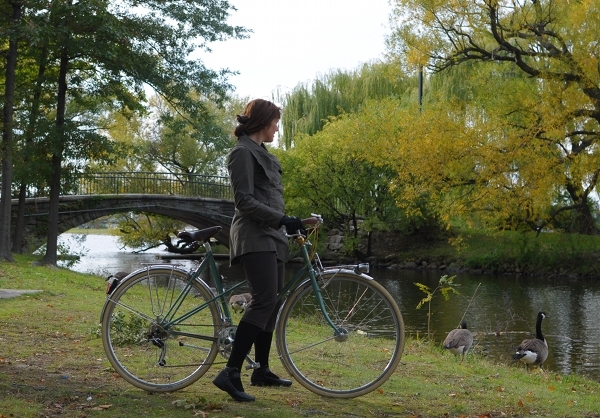 The fit of the mixte is just perfect for me, and I can feel that my proportions have been taken into consideration - everything just feels "right". The bicycle handles best with a 10cm stem, with the handlebars close to level with the saddle, and with the saddle pushed back a bit.
The fit of the mixte is just perfect for me, and I can feel that my proportions have been taken into consideration - everything just feels "right". The bicycle handles best with a 10cm stem, with the handlebars close to level with the saddle, and with the saddle pushed back a bit.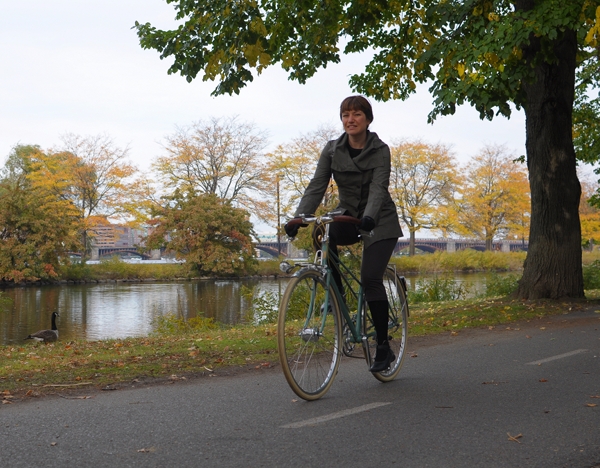 I have ridden the mixte all over town since early September, and have taken it on two longish rides (40 miles and 30 miles). Everything is beyond perfect and there is zero pain. I have tried to describe the ride quality here and here if you are interested in the details. One thing I love that I would never have expected to love, is the high bottom bracket. I feel almost majestically tall on this bicycle, even when leaned over and holding the front of the bars.
I have ridden the mixte all over town since early September, and have taken it on two longish rides (40 miles and 30 miles). Everything is beyond perfect and there is zero pain. I have tried to describe the ride quality here and here if you are interested in the details. One thing I love that I would never have expected to love, is the high bottom bracket. I feel almost majestically tall on this bicycle, even when leaned over and holding the front of the bars.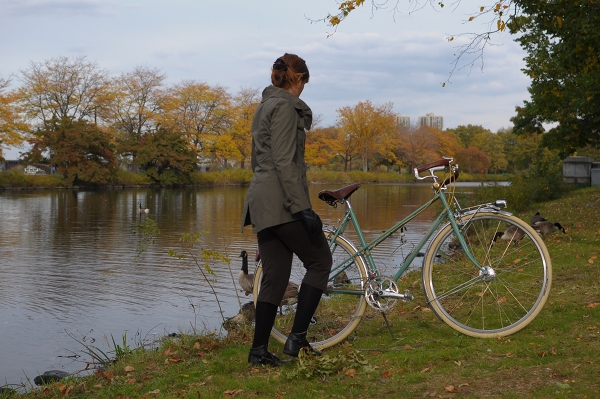 Given that this is a custom bicycle, I should probably conclude with a few words about the framebuilder. BryanHollingsworth is a young builder with considerable experience working for the world-famous Seven Cycles. He is a knowledgeable, enthusiastic, easy-going, and genuinely nice person. I knew that Bryan was the right builder for me, because he immediately understood the kind of bicycle I wanted, and got excited about building it. He was surprisingly pro-active about design solutions and pointed out possibilities that even my detail-obsessed imagination had not considered. As a result, my frame has some unique features that I cannot take any credit for what so ever; they were Bryan's idea! Additionally, now that I am actually riding the bicycle, it is clear that Bryan had put a lot of thought into making it comfortable for me, while, at the same time, giving it a degree of fiestiness that I had not expected.
Given that this is a custom bicycle, I should probably conclude with a few words about the framebuilder. BryanHollingsworth is a young builder with considerable experience working for the world-famous Seven Cycles. He is a knowledgeable, enthusiastic, easy-going, and genuinely nice person. I knew that Bryan was the right builder for me, because he immediately understood the kind of bicycle I wanted, and got excited about building it. He was surprisingly pro-active about design solutions and pointed out possibilities that even my detail-obsessed imagination had not considered. As a result, my frame has some unique features that I cannot take any credit for what so ever; they were Bryan's idea! Additionally, now that I am actually riding the bicycle, it is clear that Bryan had put a lot of thought into making it comfortable for me, while, at the same time, giving it a degree of fiestiness that I had not expected.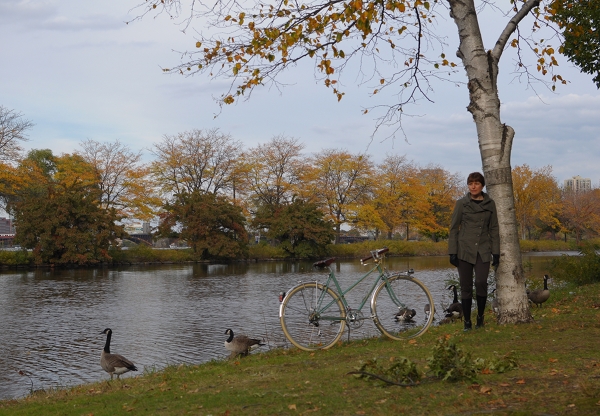 I will also address price and affordability, since some have already been asking about this. I would rather not disclose the cost of my frame - mainly because that figure will no longer be of use to anyone. When I met Bryan, he had only just begun building custom frames under his own name, and that is how I was able to afford the project. A year later, Royal H. has taken off like a rocket, and, naturally, the price structure has changed somewhat. As for affordability, my advice would be to find a frame builder you like, and then discuss the possibility of breaking up the payment into several installments. This makes paying for the frame considerably easier. Furthermore, no one says that you must buy all the components immediately, and all at once. I saved up for them gradually, which is why it took nearly a year for my bicycle to reach completion. And yes, it was worth it!
I will also address price and affordability, since some have already been asking about this. I would rather not disclose the cost of my frame - mainly because that figure will no longer be of use to anyone. When I met Bryan, he had only just begun building custom frames under his own name, and that is how I was able to afford the project. A year later, Royal H. has taken off like a rocket, and, naturally, the price structure has changed somewhat. As for affordability, my advice would be to find a frame builder you like, and then discuss the possibility of breaking up the payment into several installments. This makes paying for the frame considerably easier. Furthermore, no one says that you must buy all the components immediately, and all at once. I saved up for them gradually, which is why it took nearly a year for my bicycle to reach completion. And yes, it was worth it!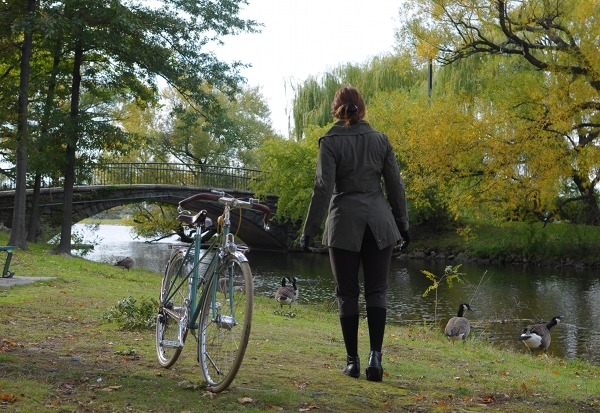 I named this bicycle "Constance", because I hope she always remains in my life. Thank you to everyone who made my custom mixte possible, both directly and indirectly.
I named this bicycle "Constance", because I hope she always remains in my life. Thank you to everyone who made my custom mixte possible, both directly and indirectly.

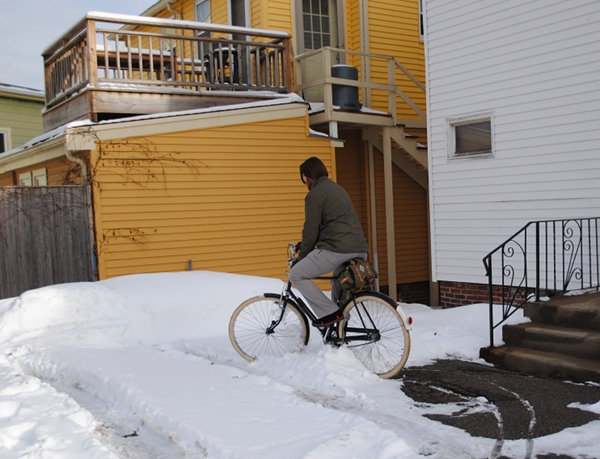 I have bragged in the past about the Co-Habitant's wonderous winter commuting skills. But truth be told, is that really so impressive to accomplish on a cushy modern Pashley? Yesterday, he tried riding Rodney - his vintage Raleigh DL-1 with rod brakes - and reports his experience:
I have bragged in the past about the Co-Habitant's wonderous winter commuting skills. But truth be told, is that really so impressive to accomplish on a cushy modern Pashley? Yesterday, he tried riding Rodney - his vintage Raleigh DL-1 with rod brakes - and reports his experience: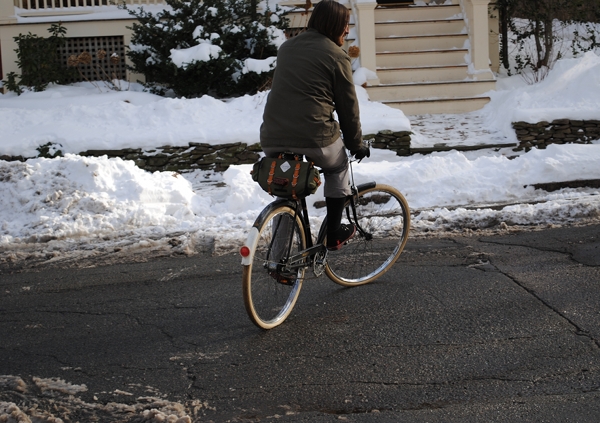 In a vintage bike, the freezing temperatures can really effect the brakes and steering. The cold stiffens the grease in the headset, making the steering extremely stiff. Of course you can rebuild the headset, but this takes either skill and time, or money to spend at the bike shop - so it is yet another issue to take into consideration when buying old bikes. Similarly, old brake pads tend to harden in the cold, compromising braking performance considerably. On regular caliper brakes, the brake pads can be replaced with new salmon KoolStops to remedy the problem. But rod brakes are incompatible with the KoolStop pads, so there is not much that can be done really.
In a vintage bike, the freezing temperatures can really effect the brakes and steering. The cold stiffens the grease in the headset, making the steering extremely stiff. Of course you can rebuild the headset, but this takes either skill and time, or money to spend at the bike shop - so it is yet another issue to take into consideration when buying old bikes. Similarly, old brake pads tend to harden in the cold, compromising braking performance considerably. On regular caliper brakes, the brake pads can be replaced with new salmon KoolStops to remedy the problem. But rod brakes are incompatible with the KoolStop pads, so there is not much that can be done really. 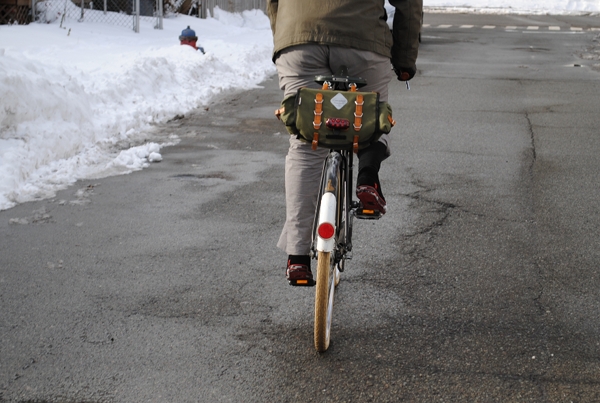 And we're out there having funin the cold Boston winter sun
And we're out there having funin the cold Boston winter sun